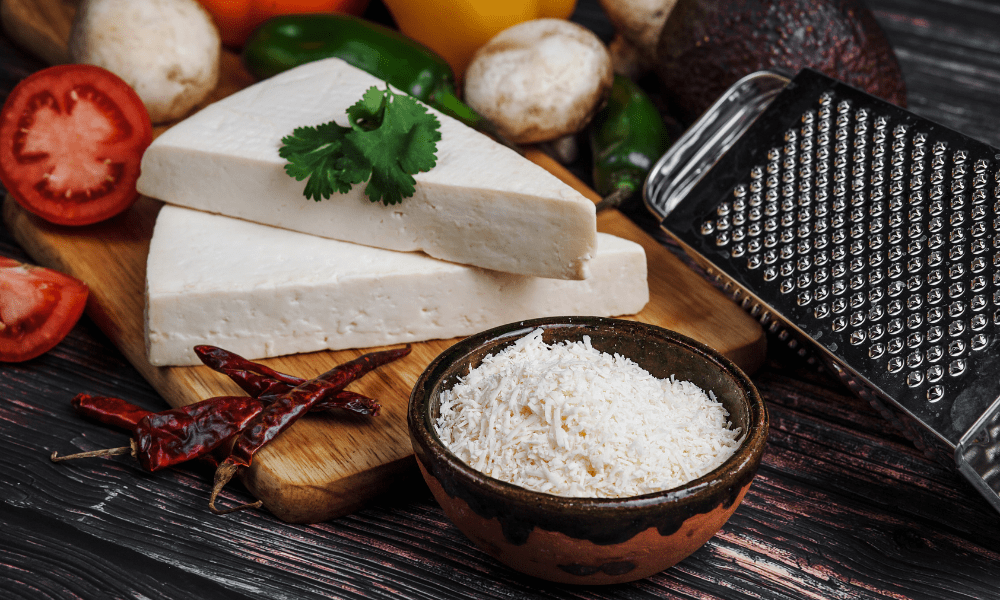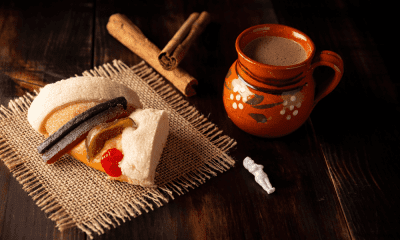Cotija Cheese: The Salty, Crumbly Delight and Its Best Substitutes
Discover the savory world of cotija cheese, a salty and crumbly delight perfect for tacos, enchiladas, and salads. Explore its best substitutes like queso fresco!


Cotija Cheese: Discover the Salty, Crumbly Delight and Its Perfect Substitutes
I remember helping my aunt prepare grilled corn on the cob in the backyard when I was a teenager. She insisted we sprinkle a specific Mexican cheese on top. I’d only known queso fresco then, so when I tasted that sharp, tangy flavor edge, I realized I was dealing with a new variety.
I discovered it was crumbly cotija cheese—some people often call it cojita cheese—and from that moment, I was hooked. If you love adding a punch of flavor to your street food or dishes such as tacos, read on to learn Everything you need to know about ingredients used in a variety of dishes, about this gem named after the town of cotija. It’s a crumbly Mexican cheese staple in many savory dishes. cotija cheese substitute
[ingredientes_receta]What is Cotija Cheese?

Chef’s Tip: 🧂 Use fresh, high-quality milk for a cleaner flavor. Avoid ultra-pasteurized types, as they can hinder proper curd formation.
Understanding Cotija as a Mexican Cheese
Cotija is a Mexican (also called cojita cheese) specialty made from cow’s milk. Cotija cheese is made in the state of Michoacán, specifically in the town of Cotija, where it first gained popularity. Because cotija is a semi-hard style, it remains distinct and doesn’t melt. You’ll find references to it in classic Mexican cooking, especially for toppings and finishing touches. It’s very similar to feta in how you can crumble it, but the aging process makes it firmer over time.
How Do They Make Cotija Cheese?
This cheese made from cow’s milk begins by curdling fresh milk, pressing it, and letting it develop a crumbly texture through curing. Some forms of aged cotija rest for months, giving them a stronger flavor. Fresh cotija might be labeled as fresh cotija, but the usual version is usually aged, giving it a bold, salty flavor. Over time, it becomes firmer, perfect for sprinkling over enchiladas, elote, or any flake-friendly cotija garnish.
Exploring the Crumbly Texture of Cotija
Cotija cheese is known for its crumbly nature: you can easily crumble it by hand as a final highlight on dishes like tacos or corn salad, which can be made with ingredients used in a variety of ways.. The cheese adds a tangy and salty flavor, often used in a variety of dishes. flavor that stands out in mexican cuisine plates. Because you can’t melt it, each piece stays separate, making it an excellent choice for a topping or garnish on everything from Tex-Mex casseroles to soups.
How Does Cotija Cheese Taste Like?

Pro Advice: 🍋 Mix in a bit of goat’s milk if you crave a sharper tang. This twist intensifies the cheese’s characteristic punch without overcomplicating the process.
Comparing Cotija to Feta Cheese
People often wonder, “Does this cheese taste like something I already know?” Indeed, it’s very similar to feta cheese in its dryness and piquant bite. If you hold them side by side, cotija’s dryness can be saltier, while feta cheese might be creamier. However, the essential concept is that both feature a somewhat tangy essence. Each can work wonders in your cooking if you’re after a bold, grainy companion.
The Salty and Crumbly Cheese Experience
You can’t skip cotija when you talk about salty and break-apart cheese. This variety offers an instantly recognizable punch that livens everything from tostadas to roasted veggies. Because it’s so firm, you might grate or crumble it on your dish. The more the cheese ages, the stronger flavor it gains, giving you a robust accent for your meals.
Why Cotija is a Favorite in Mexican Dishes
Cotija is a favorite because it provides a quick flavor boost. It adds something special if you spoon it over elote slathered in mayonnaise or scatter it on your Texan-Mexican layered dip. Also, a final shower of crumbled cotija can transform the entire plate if you’re cooking up dishes like tacos or enchiladas. Sometimes, people call it “milk cheese named** after the town of Cotija” because it draws a direct link to its origin in michoacán.
Where to Use Cotija Cheese in Cooking?
Expert Trick: ⏲️ For stronger flavor, let your formed cheese rest an extra day or two in the fridge. A short “aging” period deepens its salty, crumbly essence.
🔥 Quick Tip: 🌶️ If you enjoy spice, stir chili flakes into the curds before pressing. You’ll get a fiery kick in every crumble.
Enhancing Mexican Street Corn with Cotija
If you love mexican street corn, also known as elote, you already know how crucial it can be to use cotija cheese for that finishing flourish. Often, cooks combine mayonnaise and chili powder to coat the corn, then sprinkle the cheese on top. Because it’s a flake-friendly mexican cheese, you get distinct morsels with each bite. This is one reason it’s so common in street food.
Perfecting Salads and Enchiladas
Cotija cheese adds a dimension to any salad—a southwestern black bean mixture or a light lettuce base. A quick crumble can bring tanginess to your bowl. Another place you’ll find it layered over enchiladas for a briny pop. Even though it doesn’t melt, its dryness contrasts with the softer fillings inside your tortillas.
Adding Cotija to Soups and More
Because cotija cheese (also called cojita cheese) holds firm, it works well in soups. You can crumble it on top just before serving. It’s also a staple in savory dishes like grilled veggies, refried beans, or Tex-Mex casseroles. A sprinkle of “similar to parmesan” cheese flair means you can rely on it to remain visible and bold. That’s how you get the best payoff in each spoonful.
What are the Best Cotija Cheese Substitutes?
Chef’s Tip: 🏺 To keep the final product milder, use less salt when you mix the curds. You can always sprinkle extra salt when serving if needed.
Using Queso Fresco as an Alternative
Sometimes, you need a substitute if you can’t find cotija nearby. Queso fresco is a fresh variety that’s much more mild and somewhat creamier than a firmer aged cotija. If you compare them, queso fresco still has that crumbly approach but lacks the intense saltiness. In many mexican recipes, you can swap one for the other if you prefer a lighter profile.
Substitute with Parmesan for a Similar Kick
When searching for a cotija cheese substitute, parmesan is a handy option. Its dryness and salty edge can mimic some aspects of Cotija’s vibe. If you pick a robust wedge, you can grate it to get a comparable finishing flourish. This approach works well for tex mex style dips or topping or garnish on your black bean stew.
Although Greek feta is often pre-grated and considered among the best substitutes, it doesn’t get softer nor deliver the saltier flavor compared to feta cheese. Still, it isn’t quite like cotija in Tang, making it less ideal if you’re seeking the bold edge of cotija.
Exploring Ricotta and Añejo as Options
Ricotta is another alternative if you want something milder. While it’s less briny, it can provide a soft accent. Meanwhile, añejo is a unique pick if you crave a saltier punch. Since añejo is aged, it approaches aged cotija in depth. If you’re trying to replicate that intense dryness, añejo can be your best friend. Each substitute choice depends on how you want your dish to taste.
Exploring Mexican Recipes with Cotija Cheese

Pro Advice: 🧽 Line your draining area with enough cheesecloth or a clean sackcloth. Overlapping layers make removing and shaping the curds far easier.
Classic Tacos and Tostadas
Plenty of dishes, such as tacos or crispy tostadas, get a boost when you sprinkle cotija on top. This is especially true for Tex-Mex combos featuring spicy salsas or guacamole. The dryness complements all those saucy layers without dissolving. If you can find cotija in your local market, try it once, and you’ll be hooked.
Creating Tex Mex Delights
From layered nachos to thick burritos, you can rely on break-apart cotija cojita cheese to keep things interesting. You can crumble the cheese with ease, ensuring each portion carries a distinct flavor. It also lends a slight dairy sweetness that offsets strong spices. It’s very similar to feta cheese in that it retains shape no matter the heat or sauce.
Cotija in Traditional Mexican Cuisine
You’ll see cotija is a mexican (also called cojita cheese) treasure in all sorts of mexican cuisine, from grilled corn on the cob to big bowls of soups. Because cotija cheese is made through aging, older versions develop a more potent edge. Meanwhile, fresh cheese is milder but still has that well-known dryness. If you try cotija once, you’ll appreciate how it complements many savory dishes.
Quote: “Cotija is a semi-hard, milk cheese named after the town of cotija, with a distinct flavor that’s popular in everything from elote to texan-mexican casseroles.”
Table: Comparing Cotija and Potential Alternatives
Expert Trick: 💧 If the curds are too dry, mist them with a tablespoon of extra whey before pressing. This small moisture addition helps maintain a softer crumb.
| Cheese | Main Characteristic | Similarities to Cotija | Best Usage |
|---|---|---|---|
| Cotija Cheese | Crumbly dryness, tangy notes | Adds bold taste to Mexican street fares | Perfect for salad, enchiladas, or tacos |
| Queso Fresco | Softer, much more mild | Also a crumbly approach | Great as a finishing accent if you prefer a gentler taste |
| Parmesan | Hard wedge, can grate it | Similar dryness, used as a substitute | Ideal for strong-flavored dishes, if you need saltiness |
| Ricotta | Creamier, gentle | Not briny, but mild complement | Helpful in dips or if you want a lesser salt edge |
| Añejo | Saltier version of queso fresco | Approaches aged cotija intensity | Good for authenticity in classic mexican plates |
🔥 Quick Tip: 🧀 To mimic a longer-aged version, press your cheese firmly. Tighter compression yields a denser texture, very similar to more mature cotija in dryness.
Key Takeaways
- Producers craft cotija cheese in the state of Michoacán, specifically in the town of Cotija, which lends the cheese its name. This break-apart Mexican variety has become a staple for countless recipes.
- This made from cow’s milk variety holds a distinct flavor that can be pretty sour as it matures, giving a stronger flavor over time.
- Because it doesn’t melt, you can rely on it for a stable topping on tex-mex or more popular mexican dishes.
- If you’re curious about cotija cheese, you can think of it as a salty, dryness-forward block typically used in various meals.
- For a cotija cheese substitute, many folks choose queso fresco or parmesan. Others might try añejo or ricotta, depending on how they want to replicate that sour and salty quality.
- To see how cheese can be crumbled effectively, look at how people garnish items like enchiladas, corn salad, or even a swirl of mayonnaise on mexican street corn.
Chef’s Tip: 🌮 Keep a small container of crumbled cheese in the fridge, ready to sprinkle on tacos, beans, or salads throughout the week for an instant flavor boost.
Frequently Asked Questions about Cotija Cheese
❓ What is Cotija cheese?
Cotija cheese is a firm, crumbly Mexican cheese known for its salty, tangy flavor. It is often used as a topping for tacos, elotes, and beans.
❓ Where to buy Cotija cheese?
You can find Cotija cheese in most grocery stores, Latin markets, and online retailers. It is usually located in the dairy or specialty cheese section.
❓ Does Cotija cheese melt?
No, Cotija cheese does not melt like mozzarella or cheddar. Instead, it softens slightly when heated and is best used as a finishing topping.
❓ What does Cotija cheese taste like?
This cheese has a strong, salty, and slightly tangy flavor, similar to Parmesan. Aged versions have a more intense taste.
❓ How to pronounce Cotija cheese?
It is pronounced “Ko-TEE-ha”, with emphasis on the second syllable. The name comes from the town of Cotija in Michoacán, Mexico.
❓ Is Cotija cheese pasteurized?
In the U.S., Cotija cheese is usually made with pasteurized milk. However, traditional versions in Mexico may use raw milk.
❓ What cheese is similar to Cotija?
Feta, Parmesan, and Romano are good substitutes. They share a salty, crumbly texture and a strong flavor profile.
❓ Can you freeze Cotija cheese?
Yes, Cotija cheese can be frozen for up to 3 months. However, freezing may alter its texture, making it more crumbly.
❓ How to crumble Cotija cheese?
To crumble Cotija cheese, use a fork or your hands to break it apart. Let it sit at room temperature for easier handling.
❓ How long does Cotija cheese last?
When stored properly in an airtight container in the fridge, it can last 4-6 weeks. Aged Cotija lasts longer due to its lower moisture content.
❓ Is Cotija cheese the same as Queso Fresco?
No, Cotija is firmer, saltier, and aged, while Queso Fresco is softer and milder. Cotija is more similar to Parmesan in texture and flavor.
❓ Can pregnant women eat Cotija cheese?
Yes, if it is made from pasteurized milk. Unpasteurized cheese may pose a risk of listeria, so always check the label before consuming.
❓ Does Cotija cheese need to be refrigerated?
Yes, Cotija cheese should be stored in the refrigerator in an airtight container to maintain freshness and prevent it from drying out.
❓ Can you eat Cotija cheese raw?
Yes, it is commonly eaten raw as a topping for dishes like elote, tacos, and salads. Its salty, crumbly texture enhances many Mexican recipes.
❓ How do you store Cotija cheese properly?
Wrap it tightly in plastic wrap or place it in a resealable bag to prevent it from drying out. Keeping it in a cheese drawer helps maintain its texture.
❓ What dishes use Cotija cheese?
Cotija cheese is used in elote (Mexican street corn), tacos, tostadas, refried beans, enchiladas, soups, and Tex-Mex dips.
❓ Can I use Cotija cheese on pizza?
Yes, but it won’t melt like mozzarella. Instead, it adds a salty, crumbly texture similar to Parmesan.
❓ What’s the best substitute for Cotija cheese in tacos?
Feta or Parmesan are great substitutes, as they provide a similar salty and crumbly texture. Queso fresco is a milder option.
❓ Is Cotija cheese high in sodium?
Yes, Cotija cheese is naturally salty due to its aging process. If you’re watching your sodium intake, use it sparingly.
❓ Is Cotija cheese good for keto diets?
Yes! Cotija cheese is low in carbs and high in fat and protein, making it a keto-friendly option.
❓ Is Cotija cheese lactose-free?
While aged Cotija contains less lactose than fresh cheeses, it is not completely lactose-free. Those with lactose intolerance may tolerate it in small amounts.
Pro Advice: 🧊 Freeze leftover wedges if you can’t finish them soon. Thaw gently in the fridge, then crumble or grate for a quick topping that’s still fresh and tangy!
Conclusion
Whether you discovered cojita cheese (also called cojita cheese) at a neighborhood cookout or stumbled on cotija cheese substitutes in a pinch, there’s no denying that this beloved product is a central figure in mexican recipes. It has a crumbly texture brings a delicious accent to dishes like tacos and so many others.
Because cotija cheese is usually aged, it packs a robust punch that resonates with those who crave a punchy flair on their meals. If you ever wonder how you might replicate its effect, look for something similar to parmesan or a mild queso fresco if you need to tone down the saltiness. Ultimately, if you enjoy that tangy spark, you’ll want to keep a wedge of cotija cheese in your fridge, ready to crumble immediately.
If you’re eager to make the most of your new cheese knowledge, check out these ideas from mexican cheese made traditions:
- Homemade Gorditas Recipe
- Green Chilaquiles
- Easy Chicken Flautas
- Mexican Crema
- Lentejas (Mexican Lentil Soup)
- Chile Relleno Recipe
- Camarones a la Diabla
- Mexican Buñuelos

Homemade Cotija-Style Cheese
Equipment
- Large pot
- Instant-read thermometer
- Colander
- Cheesecloth or clean sackcloth towel
- Wooden spoon or spatula
- Heavy can or small pan (for pressing)
Ingredients
- 1 gallon whole milk avoid ultra-pasteurized
- 2/3 cup fresh lemon juice or 2/3 cup white vinegar
- Salt to taste
Instructions
- Heat the Milk
- Place the milk in a large pot over medium-low heat. Stir occasionally until it reaches about 165–180°F on your thermometer.
- Add Lemon Juice or Vinegar
- Stir in the acid (lemon juice or vinegar) 1 tablespoon at a time. Keep adding and stirring gently until curds separate from whey. Let the mixture sit for 5 to 20 minutes to complete the separation.
- Drain the Curds
- Line a colander with cheesecloth. Using a slotted spoon, transfer the curds into the colander, allowing the liquid to drain into a bowl underneath. Let the curds drain for 20 minutes if you plan to press them, or up to 1 hour for a softer consistency. Stir in salt to taste.
- Press the Cheese (Optional)
- For a firmer, more authentic cotija-style cheese, gather the curds into the center of the cloth, shape them, then tie the cloth around the cheese. Place it back in the colander with a weighted can or small pan on top. Let it press for about 1½ hours.
- Chill or Use Immediately
- Once your cheese has reached the desired texture, store it in the fridge for later, or crumble and use right away on tacos, elote, or soups.
Video
Notes
Mix in a teaspoon of chili powder or dried herbs during the salting step for extra zing.
• Firmer Texture ⏲️
Press longer (up to 2 hours) if you want a drier cheese that mimics aged cotija’s crumbly feel.
• Softer Cheese 🥛
Drain for less time and skip pressing if you prefer a fresh, moist curd—similar to queso fresco.
• Use it Everywhere 🌮
Crumble over tacos, Tex-Mex salads, or even baked casseroles for a tangy punch.
• Experiment 🧑🍳
If you’re looking for a bolder taste, sprinkle more salt; for a milder vibe, go easy on the salt. This homemade approach to cotija cheese substitute offers a crumbly, tangy finish, ideal for garnishing your favorite Mexican-inspired meals. Whether you sprinkle it on a corn salad or try it in new savory dishes, you’ll find plenty of ways to enjoy this DIY creation!
Nutrition
Nutrition Disclaimer
The Chef Marcy is not a dietician or nutritionist, and any nutritional information shared is an estimate. If calorie count and other nutritional values are important to you, we recommend running the ingredients through whichever online nutritional calculator you prefer. Calories can vary quite a bit depending on which brands were used.








thanks so much for Homemade Cotija-Style Cheese always